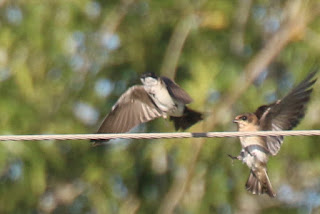I wrote this up on July 21 and later discovered that I forgot to post it. But this bird now has the TBRC seal of approval.
June birding was really slow as always so I've been doing a lot more gardening and butterfly stuff. But birding gets more interesting in July. Babies are fledged and wandering and the first fall migrants start to pass through. Yesterday I thought I would spend some time in the yard and work on my July list. It was a little dull but swallow numbers were building. I got my first Cliff Swallow for the fall. And there was a big flock of Purple Martins and some Cave, Bank and Northern Rough-winged Swallows. And then I thought I had a Tree Swallow which is really rare this early in migration.
It was gleaming white below but something wasn't right. The crown was almost black. Through the scope it had a faint purplish blue gleam. And it was smaller than a nearby rough-wing. Hmmm........ I fired some shots with the camera. The bird was about 80 yards away with with some trees behind so I to manually focus. Then the battery died. I ran inside and grabbed a new battery and returned to get some more shots. It still didn't look like a Tree Swallow. So I ran inside and edited a few of the photos. The under tail coverts were dark and not white like on a Tree Swallow. This did not seem to be one of our regular swallows. I had an idea and the South American field guides proved me right. This was a Blue-and-white Swallow. Further reading revealed that the
patagonica race of southern South America is migratory. And migratory birds sometimes get lost. I had just found the first United States record for Blue-and-white Swallow. I did not see it again during the rest of the day despite much searching.
Yesterday the reception to my find on various Face Book birding groups was lukewarm to say the best. But this morning I found the bird again and was able to get better photos. I'm finally scoring a few congratulations. I think a lot of birders are having a hard time wrapping their head around this one. Characteristics consistent with Blue-wnd-white Swallow are the small size, blue-black dorsal coloration and white under parts with some black spotting on the chest. This bird seems to be in heavy molt around the neck with some new feathers sprouting in the tail.
Flight photos show the dark rump and limited dark under tail coverts of
patagonica. The nominate nonmigratory
cyanoleuca race has much more extensive black under the tail. Also note the new tail feathers.
This bird is definitely not the bright blue-black and white bird so commonly seen in South America so I think it might be a young adult. The young tail feathers growing in are sure to mean something though I'm not sure if anyone knows anything about the molt on these swallows. So there's quite a bit of research to do before do I submit the write up for the records committee. Meanwhile normally I would now be bracing for possibly hundreds of listers to come and tick this bird. Unfortunately our Hidalgo County judge has issued a stay at home order because of the raging Covid19 in the RGV. So far only me and Mary Beth Stowe have gotten to see this bird. And that may be all.
Fast forward to 12/9/20. As it turned out the Blue-and-white Swallow was not seen again despite several days of diligent searching. I wrote up the details for the Texas Bird Records Committee and sent the photos around to some experienced ornithologist. Daniel Lane who is an associate researcher for the Louisiana State University Ornithololy Department and coauthor of Birds of Peru thought the bird looked good for Blue-and-white Swallow and that the molting tail was right for a bird that would nornmally be wintering in the Amazon basin. Several other South American experts also agreed though I got little support from the tour guides with the big birding companies. Not sure what was up with that.

Well, the TBRC has completed their vote and I got word that the bird passed unanimously. So Blue-and-white Swallow is now officially on the list of wild birds seen in Texas. The American Birding Associations checklist committee will be voting on it sometime. They usually go with the recomendations of the state committee but you never know. But if all goes well, I will have a second ABA first record. My White-crested Elaenia back in February 2008, also an austral migrant, was my first.


















































